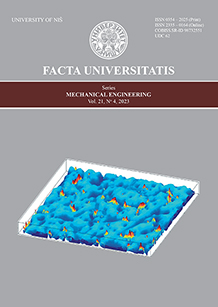IDENTIFICATION OF CHATTER VIBRATIONS AND ACTIVE VIBRATION CONTROL BY USING THE SLIDING MODE CONTROLLER ON DRY TURNING OF TITANIUM ALLOY (TI6AL4V)
IF 11.8
2区 工程技术
Q1 ENGINEERING, MECHANICAL
引用次数: 1
Abstract
In recent years, with the development of sensor technologies, communication platforms, cyber-physical systems, storage technologies, internet applications and controller infrastructures, the way has been opened to produce competitive products with high quality and low cost. In turning, which is one of the important processes of machining, chatter vibrations are among the biggest problems affecting product quality, productivity and cost. There are many techniques proposed to reduce chatter vibrations for which the exact cause cannot be determined. In this study, an active vibration control based on the Sliding Mode Control (SMC) has been implemented in order to reduce and eliminate chatter vibration, which is undesirable for the turning process. In this context, three-axis acceleration data were collected from the cutting tool during the turning of Ti6Al4V. Finite Impulse Response (FIR) filtering, Fast Fourier Transform (FFT) analysis and integral process were carried out in order to use the raw acceleration data collected over the system in control. The system is modeled mathematically and an active control block diagram is created. It is observed that chattering decreased significantly after the application of active vibration control. The surface quality formed by the amplitude of the graph obtained after active control has been compared and verified with the data obtained from the actual manufacturing result.钛合金(ti6al4v)干车削颤振辨识及滑模主动控制
近年来,随着传感器技术、通信平台、网络物理系统、存储技术、互联网应用和控制器基础设施的发展,为生产高质量、低成本的有竞争力的产品开辟了道路。车削是机械加工的重要工序之一,颤振振动是影响产品质量、生产率和成本的主要问题之一。提出了许多技术来减少颤振振动,但其确切原因无法确定。针对车削加工中存在的颤振问题,提出了一种基于滑模控制(SMC)的主动振动控制方法。在这种情况下,从Ti6Al4V车削过程中收集刀具的三轴加速度数据。为了利用采集到的原始加速度数据进行控制,对系统进行了有限脉冲响应(FIR)滤波、快速傅立叶变换(FFT)分析和积分处理。对系统进行了数学建模,建立了主动控制框图。采用主动振动控制后,系统的抖振明显减小。将主动控制后得到的图形幅值所形成的表面质量与实际制造结果所得到的数据进行了对比验证。
本文章由计算机程序翻译,如有差异,请以英文原文为准。
求助全文
约1分钟内获得全文
求助全文
来源期刊

Facta Universitatis-Series Mechanical Engineering
ENGINEERING, MECHANICAL-
CiteScore
14.40
自引率
2.50%
发文量
12
审稿时长
6 weeks
期刊介绍:
Facta Universitatis, Series: Mechanical Engineering (FU Mech Eng) is an open-access, peer-reviewed international journal published by the University of Niš in the Republic of Serbia. It publishes high-quality, refereed papers three times a year, encompassing original theoretical and/or practice-oriented research as well as extended versions of previously published conference papers. The journal's scope covers the entire spectrum of Mechanical Engineering. Papers undergo rigorous peer review to ensure originality, relevance, and readability, maintaining high publication standards while offering a timely, comprehensive, and balanced review process.
 求助内容:
求助内容: 应助结果提醒方式:
应助结果提醒方式:


